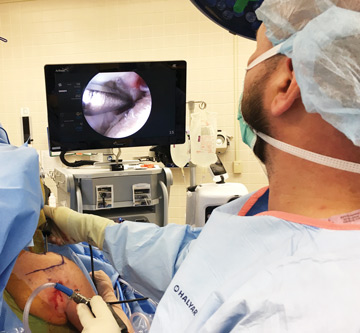Walk into an OR where 4K video is showing on flat screen monitors and try not to gawk. "The quality of the video images displayed in today's ORs are remarkable," says Christopher Schlachta, MD, a professor in the departments of surgery and oncology at the Schulich School of Medicine and Dentistry at Western University in London, Ontario.
Ultra-high-definition imaging is truly a sight to behold, but the benefits of big screen surgery go well beyond the initial wow factor. 4K monitors also allow for greater depth of color and depth perception, two key factors in helping surgeons perform intricate laparoscopic procedures. "We need to maintain instrument triangulation, accurately judge the depth of field and distances between anatomical landmarks or anatomy and our instruments," says Dr. Schlachta. The higher the resolution, the higher the color depth and the better the contrast and shading — the visual clues surgeons use to see clearer and easier.
Dr. Schlachta points out 4K video can be displayed on bigger monitors without the image quality degrading, letting surgeons zoom in on specific anatomy tissue without losing an ounce of clarity. Some large monitors come with tiling functions or split-screen functionality, letting surgical teams call up secondary displays such as MRI images without impacting the surgeon's view of the surgical display.
Gone are the days of stacking monitors on top of video towers and forcing surgeons to crane their necks in ergonomically incorrect positions to perform surgery. Large monitors can be mounted on carts and positioned farther away from the sterile field to free up space around the OR table, letting surgeons move freely and position themselves in ergonomic friendly positions.
"Place monitors throughout the OR with flow and function in mind," says Keith W. Mignault, MSBE, senior equipment planner at IMEG Corp., in Naperville, Ill. He says OR equipment should let staff move around safely and efficiently.
He suggests saving money by hanging standard definition versions on the outer walls of the OR and installing 4K monitors around the sterile field on booms or carts. "Surgeons and staff should be able to easily position the screens so they can view the images they want, where and when they want them," says Mr. Mignault. "That will help the case to go faster and smoother."
.svg?sfvrsn=be606e78_3)

.svg?sfvrsn=56b2f850_5)